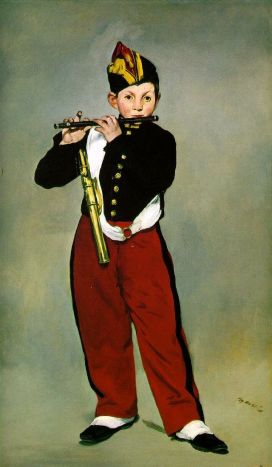
Édouard Manet was one of the first 19th-century artists to paint modern life, and a pivotal figure in the transition from Realism to Impressionism. His early works, The Luncheon on the Grass (Le déjeuner sur l’herbe) and Olympia, both painted in 1863, caused great controversy and served as rallying points for young painters who would introduce Impressionism. Today, these are considered watershed paintings that mark the genesis of modern art.
Manet put great emphasis on acceptance by the Paris Salon. In fact, he believed that success as an artist could only be obtained through recognition at the Salon.
Spanish Guitar Player, painted in 1862, reflected the Parisian love of “all things Spanish” and was one of Manet’s first works to be accepted by the Salon, however it was not this painting which brought his much sought after recognition (notoriety) but the rejected Dejeuner sur l’herbe.
He became friends with the Impressionists Edgar Degas, Claude Monet, Pierre-Auguste Renoir, Alfred Sisley, Paul Cézanne and Camille Pissarro through another painter, Berthe Morisot, who was a member of the group and drew him into their activities. She is credited with convincing Manet to attempt plein air painting, which she had been practicing since she was introduced to it by another friend of hers, Camille Corot.
Although his own work influenced and anticipated the Impressionist style, he resisted involvement in Impressionist exhibitions, partly because he didn’t wish to be seen as the representative of a group identity, and partly because he wanted the prestige of exhibiting at the Salon.
He was influenced by other Impressionists, especially Monet and Morisot. Their influence is seen in Manet’s use of lighter colours, but he retained his distinctive use of black, uncharacteristic of Impressionist painting. He painted many outdoor (plein air) pieces, but always returned to what he considered the serious work of the studio.
Some of Manet’s best-loved works are his café scenes. His completed paintings were often based on small sketches he made while out socializing. These works, including At the Café, The Beer Drinkers and The Café Concert, amongst others, depict 19th-century Paris. He sought to illuminate the rituals of both common and bourgeoisie French people. His subjects are reading, waiting for friends, drinking and working. In stark contrast to his café scenes, Manet also painted the tragedies and triumphs of war.










In my next blog more about Manet…